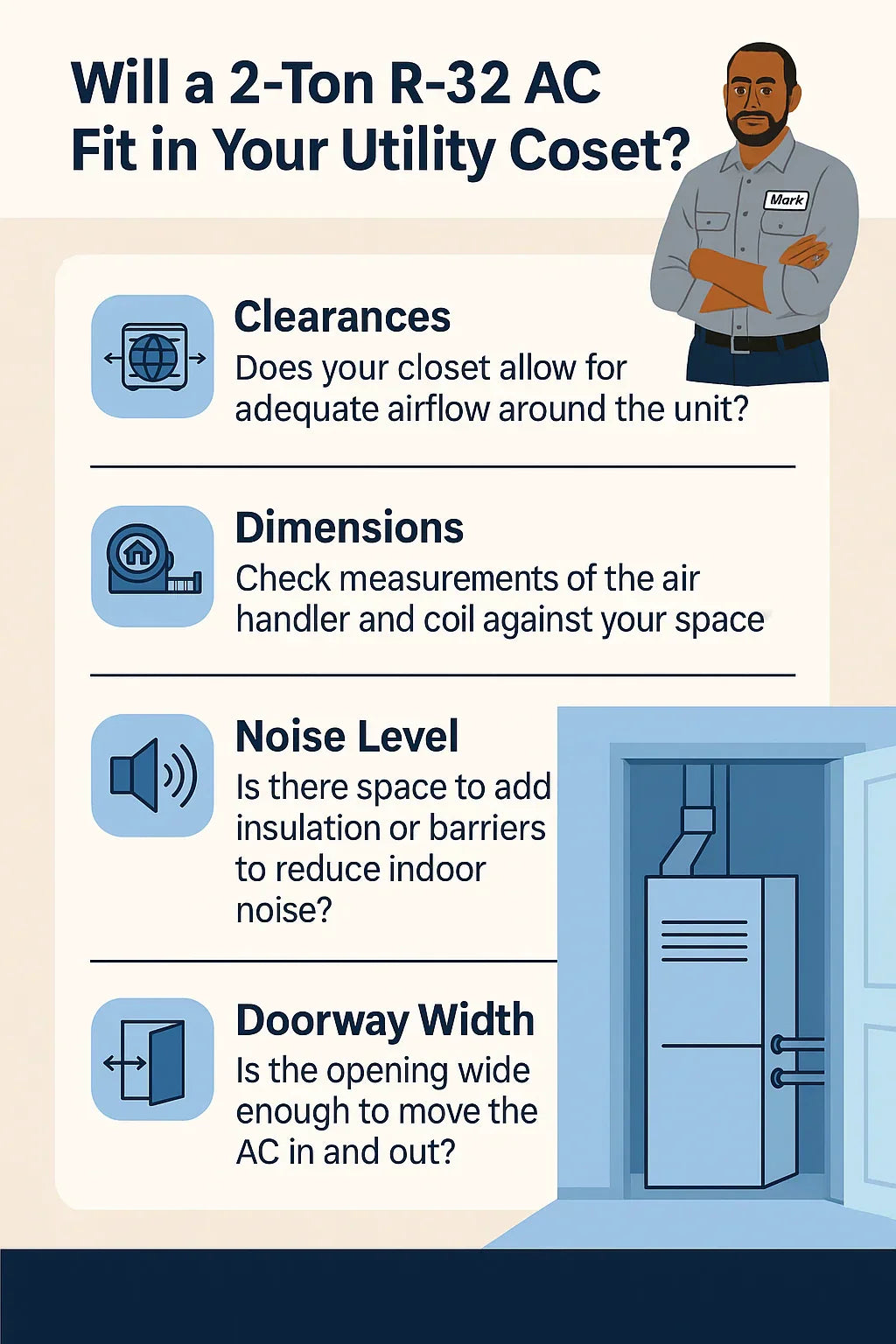🏡 Why This Matters for Mark
Before Mark Callahan purchases a 2-ton R-32 AC system, he needs to confirm it will fit within his utility closet, attic, or outdoor pad area without violating code, airflow requirements, or causing unnecessary noise.
📦 Typical Dimensions for 2-Ton R-32 Units
Outdoor condenser:
-
Height: 24–36 inches
-
Width: 24–36 inches
-
Depth: 24–36 inches
Air handler/evaporator coil:
-
Height: 30–50 inches (vertical models)
-
Width: 18–24 inches
-
Depth: 20–28 inches
Always check the specific model’s manual for exact measurements.
🛠️ Required Clearances for Installation
✅ Outdoor Unit:
-
At least 12–18 inches clearance on all sides for airflow.
-
At least 5 feet above the unit should be clear of obstructions.
-
Mounted on a level pad or brackets for drainage.
✅ Indoor Air Handler/Furnace:
-
Allow service clearance in front (24–36 inches).
-
Maintain clearance around sides for airflow.
-
Check attic or closet height and width before purchase.
Learn more:
🔊 Noise Considerations
R-32 outdoor condensers:
-
Typical sound levels: 55–70 dB.
-
Quieter than older systems due to improved compressor and fan designs.
Tips to reduce perceived noise:
✅ Install on vibration-isolating pads.
✅ Position away from bedroom windows.
✅ Use fencing or landscaping to deflect noise (without blocking airflow).
🏷️ Code and Permit Requirements
✅ Local codes may dictate minimum clearances and pad requirements.
✅ Electrical disconnects must be accessible.
✅ Drainage should prevent water pooling near the foundation.
✅ Permit fees typically range from $100–$500.
Discuss these with your licensed installer to avoid last-minute issues.
📐 Utility Closet/Attic Fit Checklist for Mark
✅ Measure current HVAC cabinet dimensions.
✅ Check access doors for air handler/furnace.
✅ Verify drain pan and drain line routes.
✅ Confirm ceiling height in attic installs.
✅ Inspect for sufficient airflow paths around the unit.
🧰 Ductwork Considerations
✅ Ensure supply and return ducts match system airflow requirements.
✅ Duct sealing and insulation improve efficiency.
✅ Larger return grilles may be needed to reduce noise and ensure airflow.
🛡️ Design Considerations for Long-Term Performance
✅ Plan pad or platform location to allow future service access.
✅ Keep outdoor units in shaded areas to improve efficiency.
✅ Use proper vibration dampening to protect structural integrity.
✅ Maintain airflow clearance for efficient heat exchange.
✅ Key Takeaways
-
Measure your utility space before purchasing a 2-ton R-32 system.
-
Maintain clearances for airflow and code compliance.
-
Use noise-reducing placement strategies if needed.
-
Confirm ductwork and drain routing for efficiency.
👉 Ready to Check Fit and Shop?
View R-32 AC and Gas Furnaces – 2 Ton Collection
In the next topic we will know more about: Is a 2-Ton R-32 AC System Right for Your Home? Sizing Tips & Floorplan Guidance







